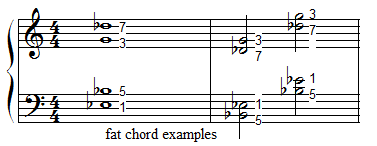Once you’ve learned basic chord structure you will begin to enter the realm of chord voicing, which is how to you use chord notes in various combinations and reordered to create a different sound using the same chord or scale notes.
The Creating Chords Workshop takes a great deal of time in learning 3 and 4 note chord structures addressing major, minor, diminished and augmented chords. You develop your ability in spelling them and then understanding inversions to produce some simple voicing alternatives. The inversions allow close chord progressions by voicing those chords so that movement from one to the next is very tight.
Gaining a complete handle on chord spellings then gives you an ability to pursue more chord voicing options.
Classical Chord Voicing
Let’s understand how most classical music voices the chords. In the simplest form a chord uses 3 basic notes. Using the standard 1 through 8 scale tone numbering the triad chord is made up of a root (1), a third (3), and a fifth interval (5).
In the example below the first measure shows a root position chord and a full melody line using the chord using root – 3 – 5 – 8. In the second measure I’ve shown a simple 1 – 5 – 8 chord voicing using the root, a fifth, and the octave (8). This voicing is only a part of the chord, but as you can see I can use what would have been the 3rd in a higher octave to complete the chord tones.

Inversion Voicing
In the next example we can invert a chord to be played as a 5 – 1 – 3, a 2nd inversion. Using this voicing I can play chord tones and scale tones in the melody which fit into the concept of playing a song that is using this chord. Then continue on with a 1st inversion and continue to play the melody with scale tones.

Fat Chord Voicing
Taking this a bit further you may voice a seventh chord into what is called a fat chord. That is spreading out the notes of a chord across two octaves. In its simplest form you are picking notes that have a large interval separation, but using the notes of the chord.
Here is one that might work. Using the Eb7 chord you might voice it as 1 – 5 – 3 – 7 (huge interval spacing) or using an inversion technique to voice as 5 – 1 – 7 – 3 as shown below.

Simple Understanding of Chord Voicing
This basic introduction is to get you thinking about what voicing means and how you might apply this in composing or harmonizing a part of a song.
This idea is nothing more than knowing what chord you are using and playing the notes of that chord in different order and different positions. The fit of the voicing will be related to the melody and the flow or movement of the music as you progress from one chord to another.
In the next article we can exam how to apply this to jazz voicing where we use the extended notes of chords such as 9ths and 13ths.
For now take a four note chord such as a DM7 or a F7 and see how many variations of those four notes you can create in a two octave range.
Reference lessons:
Intervals page and Notes Workshop